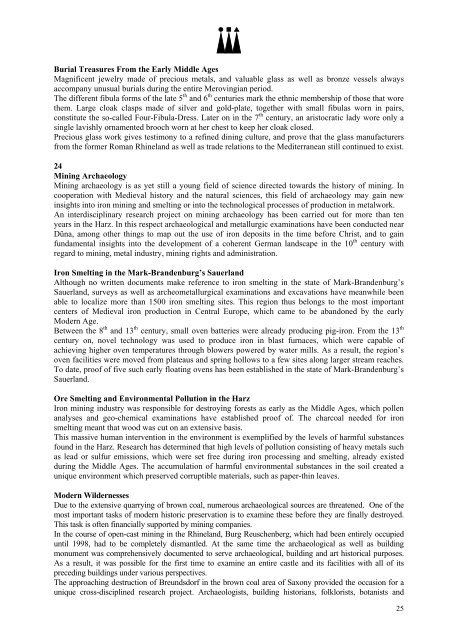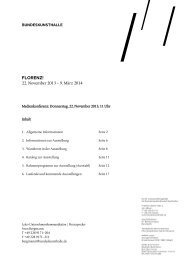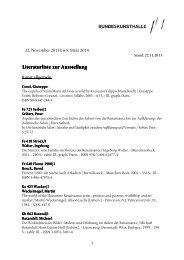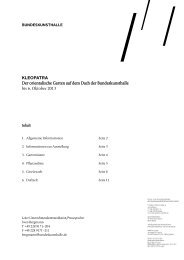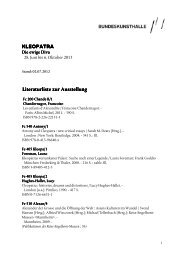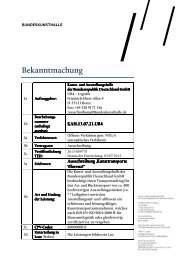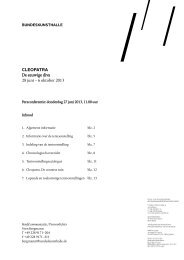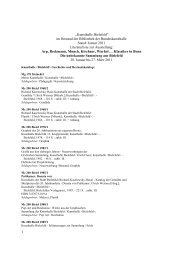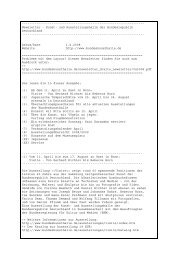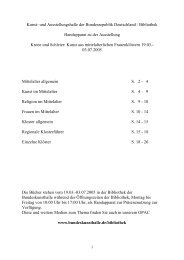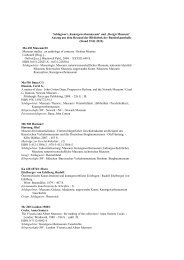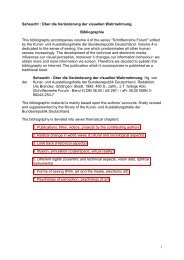Peoples through space and time Archaeology in Germany 09.05 ...
Peoples through space and time Archaeology in Germany 09.05 ...
Peoples through space and time Archaeology in Germany 09.05 ...
You also want an ePaper? Increase the reach of your titles
YUMPU automatically turns print PDFs into web optimized ePapers that Google loves.
Burial Treasures From the Early Middle Ages<br />
Magnificent jewelry made of precious metals, <strong>and</strong> valuable glass as well as bronze vessels always<br />
accompany unusual burials dur<strong>in</strong>g the entire Merov<strong>in</strong>gian period.<br />
The different fibula forms of the late 5 th <strong>and</strong> 6 th centuries mark the ethnic membership of those that wore<br />
them. Large cloak clasps made of silver <strong>and</strong> gold-plate, together with small fibulas worn <strong>in</strong> pairs,<br />
constitute the so-called Four-Fibula-Dress. Later on <strong>in</strong> the 7 th century, an aristocratic lady wore only a<br />
s<strong>in</strong>gle lavishly ornamented brooch worn at her chest to keep her cloak closed.<br />
Precious glass work gives testimony to a ref<strong>in</strong>ed d<strong>in</strong><strong>in</strong>g culture, <strong>and</strong> prove that the glass manufacturers<br />
from the former Roman Rh<strong>in</strong>el<strong>and</strong> as well as trade relations to the Mediterranean still cont<strong>in</strong>ued to exist.<br />
24<br />
M<strong>in</strong><strong>in</strong>g <strong>Archaeology</strong><br />
M<strong>in</strong><strong>in</strong>g archaeology is as yet still a young field of science directed towards the history of m<strong>in</strong><strong>in</strong>g. In<br />
cooperation with Medieval history <strong>and</strong> the natural sciences, this field of archaeology may ga<strong>in</strong> new<br />
<strong>in</strong>sights <strong>in</strong>to iron m<strong>in</strong><strong>in</strong>g <strong>and</strong> smelt<strong>in</strong>g or <strong>in</strong>to the technological processes of production <strong>in</strong> metalwork.<br />
An <strong>in</strong>terdiscipl<strong>in</strong>ary research project on m<strong>in</strong><strong>in</strong>g archaeology has been carried out for more than ten<br />
years <strong>in</strong> the Harz. In this respect archaeological <strong>and</strong> metallurgic exam<strong>in</strong>ations have been conducted near<br />
Düna, among other th<strong>in</strong>gs to map out the use of iron deposits <strong>in</strong> the <strong>time</strong> before Christ, <strong>and</strong> to ga<strong>in</strong><br />
fundamental <strong>in</strong>sights <strong>in</strong>to the development of a coherent German l<strong>and</strong>scape <strong>in</strong> the 10 th century with<br />
regard to m<strong>in</strong><strong>in</strong>g, metal <strong>in</strong>dustry, m<strong>in</strong><strong>in</strong>g rights <strong>and</strong> adm<strong>in</strong>istration.<br />
Iron Smelt<strong>in</strong>g <strong>in</strong> the Mark-Br<strong>and</strong>enburg’s Sauerl<strong>and</strong><br />
Although no written documents make reference to iron smelt<strong>in</strong>g <strong>in</strong> the state of Mark-Br<strong>and</strong>enburg’s<br />
Sauerl<strong>and</strong>, surveys as well as archeometallurgical exam<strong>in</strong>ations <strong>and</strong> excavations have meanwhile been<br />
able to localize more than 1500 iron smelt<strong>in</strong>g sites. This region thus belongs to the most important<br />
centers of Medieval iron production <strong>in</strong> Central Europe, which came to be ab<strong>and</strong>oned by the early<br />
Modern Age.<br />
Between the 8 th <strong>and</strong> 13 th century, small oven batteries were already produc<strong>in</strong>g pig-iron. From the 13 th<br />
century on, novel technology was used to produce iron <strong>in</strong> blast furnaces, which were capable of<br />
achiev<strong>in</strong>g higher oven temperatures <strong>through</strong> blowers powered by water mills. As a result, the region’s<br />
oven facilities were moved from plateaus <strong>and</strong> spr<strong>in</strong>g hollows to a few sites along larger stream reaches.<br />
To date, proof of five such early float<strong>in</strong>g ovens has been established <strong>in</strong> the state of Mark-Br<strong>and</strong>enburg’s<br />
Sauerl<strong>and</strong>.<br />
Ore Smelt<strong>in</strong>g <strong>and</strong> Environmental Pollution <strong>in</strong> the Harz<br />
Iron m<strong>in</strong><strong>in</strong>g <strong>in</strong>dustry was responsible for destroy<strong>in</strong>g forests as early as the Middle Ages, which pollen<br />
analyses <strong>and</strong> geo-chemical exam<strong>in</strong>ations have established proof of. The charcoal needed for iron<br />
smelt<strong>in</strong>g meant that wood was cut on an extensive basis.<br />
This massive human <strong>in</strong>tervention <strong>in</strong> the environment is exemplified by the levels of harmful substances<br />
found <strong>in</strong> the Harz. Research has determ<strong>in</strong>ed that high levels of pollution consist<strong>in</strong>g of heavy metals such<br />
as lead or sulfur emissions, which were set free dur<strong>in</strong>g iron process<strong>in</strong>g <strong>and</strong> smelt<strong>in</strong>g, already existed<br />
dur<strong>in</strong>g the Middle Ages. The accumulation of harmful environmental substances <strong>in</strong> the soil created a<br />
unique environment which preserved corruptible materials, such as paper-th<strong>in</strong> leaves.<br />
Modern Wildernesses<br />
Due to the extensive quarry<strong>in</strong>g of brown coal, numerous archaeological sources are threatened. One of the<br />
most important tasks of modern historic preservation is to exam<strong>in</strong>e these before they are f<strong>in</strong>ally destroyed.<br />
This task is often f<strong>in</strong>ancially supported by m<strong>in</strong><strong>in</strong>g companies.<br />
In the course of open-cast m<strong>in</strong><strong>in</strong>g <strong>in</strong> the Rh<strong>in</strong>el<strong>and</strong>, Burg Reuschenberg, which had been entirely occupied<br />
until 1998, had to be completely dismantled. At the same <strong>time</strong> the archaeological as well as build<strong>in</strong>g<br />
monument was comprehensively documented to serve archaeological, build<strong>in</strong>g <strong>and</strong> art historical purposes.<br />
As a result, it was possible for the first <strong>time</strong> to exam<strong>in</strong>e an entire castle <strong>and</strong> its facilities with all of its<br />
preced<strong>in</strong>g build<strong>in</strong>gs under various perspectives.<br />
The approach<strong>in</strong>g destruction of Breundsdorf <strong>in</strong> the brown coal area of Saxony provided the occasion for a<br />
unique cross-discipl<strong>in</strong>ed research project. Archaeologists, build<strong>in</strong>g historians, folklorists, botanists <strong>and</strong><br />
25


